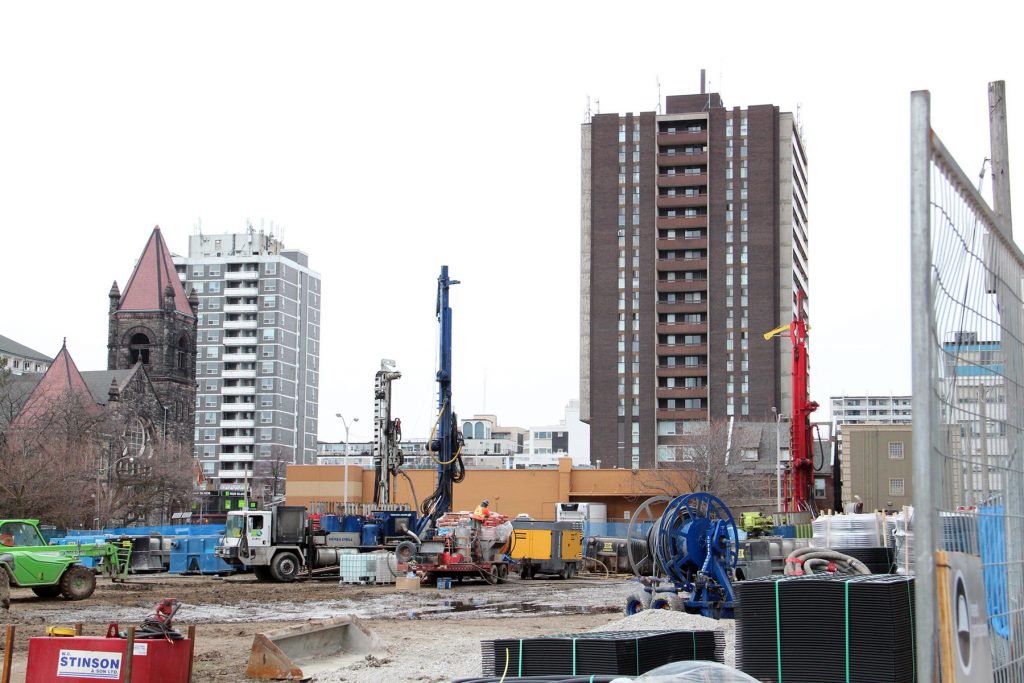U of T seeks big win on greenhouse gas reductions

By Nicole Stoffman
Green energy from the deep earth is coming to the Annex. The University of Toronto is drilling one hundred and fifty-three 850-foot boreholes into the Robert Street Field in order to extract geothermal energy to provide heating and cooling to the future Spadina-Sussex Student Residence and connect to the University on the other side of Spadina.
“It will be the deepest large project in Canada,” says Brian Beatty of Beatty Geothermal Consulting.
Geothermal energy systems take advantage of the fact that the earth 10 feet below the surface maintains a temperature of 11-12 degrees Celsius year-round. Fluid running through pipes that go down into the boreholes absorb heat, bring that heat to the surface and then transfers it to a heat pump that warms the air circulated throughout a building.
In summer, heat from the building warms up the water going into the borehole loop and transfers it to the rock. The cool water flowing back can then be used to cool the building.
This project will mean a 90% reduction in greenhouse gas emissions for heating and cooling university buildings, compared with natural gas.
That’s an annual reduction of 1,150 tons of carbon dioxide. It is in lock step with the university’s pledge to fight climate change and reduce campus-wide emissions 37% by 2030, and to reach carbon neutrality by 2050.
“There was a plan to revitalize the Robert Street Field, and this presented an opportunity,” says Campus & Facilities’ David Sasaki.“This is exactly the kind of big step necessary to create a cleaner, healthier system.”
The 7 million dollar project is expected to pay for itself within 28 years.
At a recent public meeting, Councillor Mike Layton said that if the neighbourhood could tap into this geothermal system instead of gas it could be a model for the City of Toronto on how to integrate sustainability into recreational facilities, and connect to urban growth.
The city has pledged to be net zero by 2050, and is supporting green community initiatives under its “Transform TO” action strategy. Since buildings account for 50% of carbon emissions, the city could consider tying into this geothermal field.
The U of T is not opposed to a future partnership, and talks with the city are ongoing.
“The community would be delighted to discuss the opportunity to feed into the system,” says Susan Dexter of the Harbord Village Residents’ Association. “It is very clear geothermal is the quickest route to reducing household carbon emissions.”
Geothermal technology is not new and Canada has significant potential to tap into this energy source.
However, the initial investment into these systems is high, so it requires long-term vision to justify the pay-off.
“Geothermal is a very clean, renewable source of electricity,” says Jack Gibbons, chair of the Ontario Clean Air Alliance. “It will help the U of T reduce its natural gas consumption. We must phase out fossil fuels and move to renewable energy to protect our climate.”
The end result will be a revitalized and expanded natural sod playing field.
The Robert Street skating rink, change rooms, and tennis courts will be demolished, but will be replaced by an inviting community park featuring a butterfly garden, playground, climbing boulders, and seasonal plantings.
STUDIO tla Landscape Architects will complete the park by the end of summer.
Geosource Energy Inc. will complete the field by June 2020.
